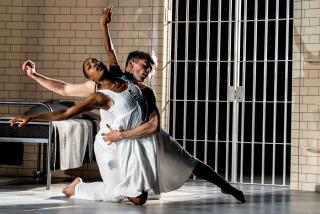Bourne reshapes ‘Scissorhands’
- Share via
ENDANGERED outsiders are central to the acclaimed full-evening dance dramas of Matthew Bourne, whether they’re an alienated prince (“Swan Lake”), a shellshocked pilot (“Cinderella”), a reckless bisexual drifter (“The Car Man”) or a waif trapped in a dismal orphanage (“Nutcracker!”).
However, the most helpless outsider in Bourne’s body of work just might be the childlike title character in “Edward Scissorhands,” coming to the Ahmanson Theatre for a three-week run starting Dec. 12. “Edward is like a baby,” Bourne said not long ago in his native London. “He learns about people and grows up during the piece. I’m drawn to stories that go somewhere, where characters change within them.”
In this case, the story comes from the hit 1990 Tim Burton film that starred Johnny Depp and Winona Ryder, with music by Danny Elfman. Bourne has kept themes from the soundtrack score (arranged by Terry Davies) and worked with the original screenwriter, Caroline Thompson, to adapt Burton’s wry fable about a picturesquely maimed youth encountering love and hostility in suburbia.
But as he explains, it isn’t always easy “making something that’s cinematic into something that’s theatrical. Some scenes you rule out straight away because they don’t lend themselves to dance. Others you expand. There’s a short barbecue scene in the film, and it’s now longer, because there’s an opportunity for social dancing. There’s also a Christmas element in the film -- a party, but it doesn’t happen because no one comes -- and now it’s a big event that the town has every year, a chance to bring in a different kind of music: the parents’ music, maybe.”
Everyone who saw the film remembers that Edward was a whiz at topiary sculpture, and Bourne has used those scenes as the basis for a whimsical dream ballet. “It’s how Edward wants it to be in his perfect world,” Bourne says, “a world full of his creations.” The result may remind some viewers of the “Jardin Anime” divertissement from the 19th century ballet “Le Corsaire.” But Bourne links it to the great British choreographer Frederick Ashton, in particular Ashton’s tongue-in-cheek costume fantasy, “Pas des Legumes.”
Ultimately, Bourne says, he wanted to retell the story “for an audience that may not have seen the film. So there was a certain amount of explanation needed. Which is why there’s a prologue now. And our ending is very different as well. In the film, Edward stays up in the castle, creating things -- and it didn’t ring true to me. I wanted you to not quite know what happens to him: Did he disappear? Is his spirit there somehow?
“You can read it several ways. In the theater, it’s easier to do something that’s more ambiguous.”
More to Read
Only good movies
Get the Indie Focus newsletter, Mark Olsen's weekly guide to the world of cinema.
You may occasionally receive promotional content from the Los Angeles Times.








